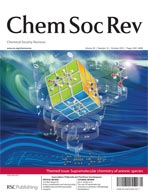This month sees the following articles in ChemSocRev that are in the top ten most accessed:-
Graphene-based materials in electrochemistry
Da Chen, Longhua Tang and Jinghong Li
Chem. Soc. Rev., 2010, 39, 3157 – 3180, DOI: 10.1039/b923596e, Critical Review
Designing multifunctional quantum dots for bioimaging, detection, and drug delivery
Pavel Zrazhevskiy, Mark Sena and Xiaohu Gao
Chem. Soc. Rev., 2010, DOI: 10.1039/b915139g, Critical Review
The uses of supramolecular chemistry in synthetic methodology development: examples of anion and neutral molecular recognition
Leo A. Joyce, Shagufta H. Shabbir and Eric V. Anslyn
Chem. Soc. Rev., 2010, 39, 3621 – 3632, DOI: 10.1039/b926224p, Tutorial Review
Microfluidic lab-on-a-chip platforms: requirements, characteristics and applications
Daniel Mark, Stefan Haeberle, Günter Roth, Felix von Stetten and Roland Zengerle
Chem. Soc. Rev., 2010, 39, 1153 – 1182, DOI: 10.1039/b820557b, Critical Review
Next-generation peptide nanomaterials: molecular networks, interfaces and supramolecular functionality
Mischa Zelzer and Rein V. Ulijn
Chem. Soc. Rev., 2010, 39, 3351 – 3357, DOI: 10.1039/c0cs00035c, Highlight
Semiconducting polymers: the Third Generation
Alan J. Heeger
Chem. Soc. Rev., 2010, 39, 2354 – 2371, DOI: 10.1039/b914956m, Tutorial Review
Probing peptide-nanomaterial interactions
Joseph M. Slocik and Rajesh R. Naik
Chem. Soc. Rev., 2010, 39, 3454 – 3463, DOI: 10.1039/b918035b, Tutorial Review
More than just bare scaffolds: towards multi-component and decorated fibrous biomaterials
Derek N. Woolfson and Zahra N. Mahmoud
Chem. Soc. Rev., 2010, 39, 3464 – 3479, DOI: 10.1039/c0cs00032a, Critical Review
Aromaticity and photophysical properties of various topology-controlled expanded porphyrins
Jae-Yoon Shin, Kil Suk Kim, Min-Chul Yoon, Jong Min Lim, Zin Seok Yoon, Atsuhiro Osuka and Dongho Kim
Chem. Soc. Rev., 2010, 39, 2751 – 2767, DOI: 10.1039/b925417j, Tutorial Review
Power struggles in peptide-amphiphile nanostructures
Frank Versluis, Hana Robson Marsden and Alexander Kros
Chem. Soc. Rev., 2010, 39, 3434 – 3444, DOI: 10.1039/b919446k, Tutorial Review
Why not take a look at the articles today and blog your thoughts and comments below.
Fancy submitting an article to ChemSocRev? Then why not email us today with your suggestions.














